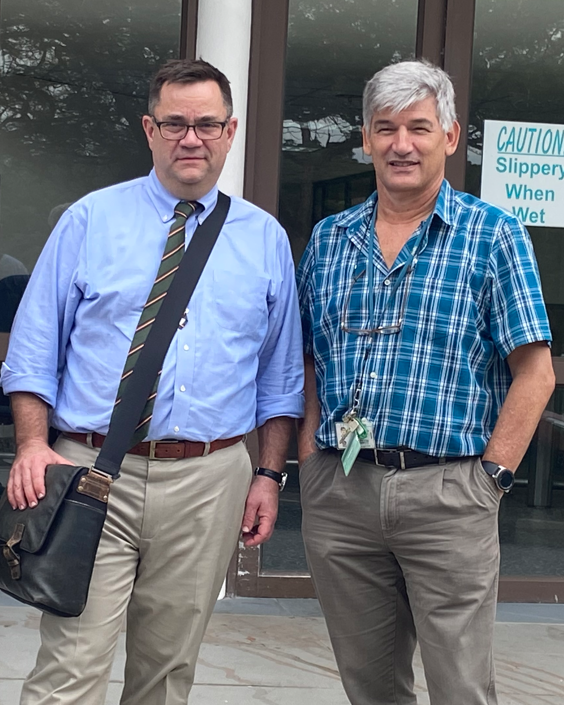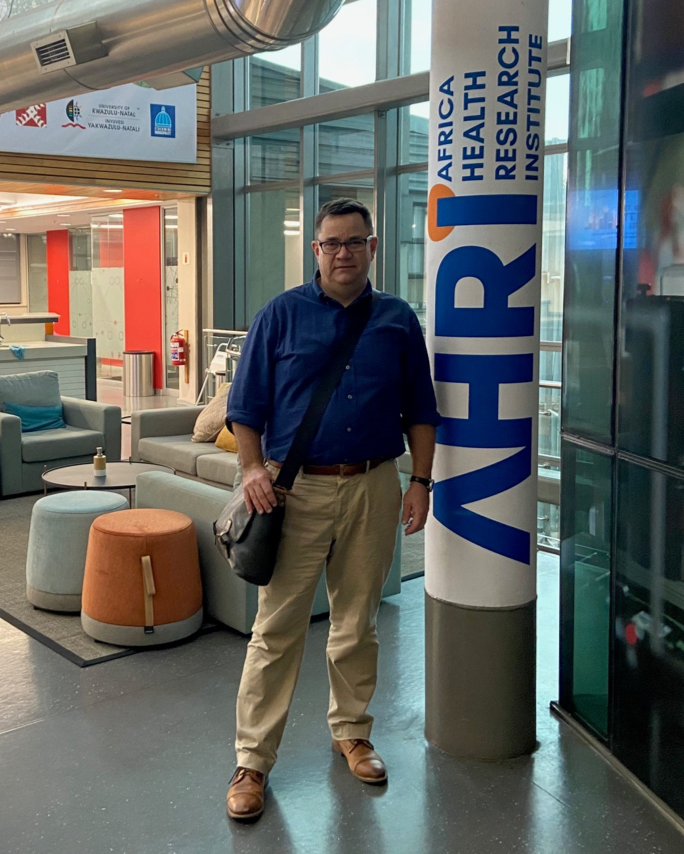 Paul V. Benson, M.D., and Adrie J. C. Steyn, Ph.D. Extended research has been conducted to understand how Mycobacterium tuberculosis (Mtb) can remain in the body for many years without causing any symptoms of the disease, only to suddenly become active and cause an explosive outbreak of tuberculosis (TB).
Paul V. Benson, M.D., and Adrie J. C. Steyn, Ph.D. Extended research has been conducted to understand how Mycobacterium tuberculosis (Mtb) can remain in the body for many years without causing any symptoms of the disease, only to suddenly become active and cause an explosive outbreak of tuberculosis (TB).
Mary Heersink Institute for Global Health (MHIGH) launched its pilot project grant to promote cooperation and provide resources among researchers at UAB and global collaborators in their efforts to address urgent global health issues.
MHIGH announced its first pilot grant cohort in 2022, and among these were principal investigator Adrie J. C. Steyn, Ph.D., professor in the Department of Microbiology, and co-investigator Paul V. Benson, M.D., associate professor in the Department of Pathology.
Steyn and Benson discussed the partnership between the African Health Research Institute (AHRI) in Durban, South Africa and MHIGH and how this partnership has enabled further research of TB pandemic in South Africa.
Q: What is the progress of the pilot project? How has MHIGH facilitated your research?
Benson: It is truly marvelous. Being able to engage in intercontinental research collaborations has significantly enhanced my experience at UAB. It has granted me opportunities I believe would not have been possible otherwise. Specifically, it has allowed me to delve into research and establish partnerships that originated during the COVID pandemic and have now extended to TB. This progress, both in Birmingham and at AHRI, is advancing quite well. It has created an opportunity for me that I never anticipated or believed possible and has empowered me to engage in endeavors that I never thought I would have the chance to pursue.
Steyn: The pilot project has unlocked remarkable opportunities that were previously out of reach for us, and I find it truly inspiring. As a former South African who has become a U.S. citizen and still maintains a lab at UAB, I am grateful for the immense support I have received. UAB has allowed me to be seconded and established a presence in South Africa, bridging the two continents and fostering scientific exchange in eductaion and research. It is a privilege to be a part of this endeavor, made possible by the goodwill of the American people, UAB, and MHIGH.
Q: Could you describe the collaboration between AHRI and MHIGH?
Steyn: The partnership between AHRI and MHIGH created a positive impact. In my opinion, there exists a strong and stable foundation, providing ample room for growth and incredible scientific prospects. These opportunities extend beyond TB and HIV, encompassing various communicable and non-communicable diseases. Additionally, there is an abundance of training opportunities for students, postdocs, and clinical fellows available in this context. Recently, we have had the opportunity for the MHIGH group of scientists to come and visit us, resulting in new synergies being formed.
Q: What sparked this deep passion for gloabl health?
Steyn: Several years ago, when I left South Africa to complete my Ph.D. in the United States, I embarked on a journey that led me to a different field of study. It was during this time that I developed a keen interest in infectious diseases, particularly TB. Leaving my country and encountering people in the U.S. who were surprised by the lack of awareness about TB issues in South Africa prompted me to reflect on my own ignorance. Despite it being many years ago, I can recall the realization I had to face abroad regarding the TB challenges in my home country. Now, after receiving education and training in the U.S., I have a unique opportunity to give back and make a positive impact in South Africa.
Q: What does the research and training in this area involve? What advancements have been made in terms of improving treatment or possibly preventing tuberculosis?
 Paul V. Benson, M.D. Steyn: The progress in TB research has been slow due to the slow growth of the organism and limited understanding of the pathogen. Every 20 seconds, someone dies of TB, with 1.2 million annual deaths and 2 billion people latently infected, serving as a significant reservoir for future cases. The economic impact of an individual with multidrug-resistant TB in the U.S. was $250,000 in 1994, emphasizing the substantial economic and health burdens. The partnership between South Africa and UAB allows focused studies, particularly on human TB tissue. Routine access to human specimens and collaboration with experts like Paul Benson has enabled the examination of autopsy cases, providing valuable insights into TB pathology. Previous reliance on animal models has limited our understanding of human TB disease. By combining expertise and available specimens, significant strides have been made in understanding how TB causes disease in humans.
Paul V. Benson, M.D. Steyn: The progress in TB research has been slow due to the slow growth of the organism and limited understanding of the pathogen. Every 20 seconds, someone dies of TB, with 1.2 million annual deaths and 2 billion people latently infected, serving as a significant reservoir for future cases. The economic impact of an individual with multidrug-resistant TB in the U.S. was $250,000 in 1994, emphasizing the substantial economic and health burdens. The partnership between South Africa and UAB allows focused studies, particularly on human TB tissue. Routine access to human specimens and collaboration with experts like Paul Benson has enabled the examination of autopsy cases, providing valuable insights into TB pathology. Previous reliance on animal models has limited our understanding of human TB disease. By combining expertise and available specimens, significant strides have been made in understanding how TB causes disease in humans.
Benson: Another aspect of the project, in addition to the MHIGH fostering collaborations, involves technological advancements driving research. The nano computed tomography (CT) scanner, a powerful instrument at AHRI in South Africa, has begun showing its productivity, along with emerging technologies like spatial transcriptomics. These technologies will be utilized to leverage specimens from both AHRI and UAB. An intriguing discovery from this collaboration is the realization that TB is not a significant issue in the U.S.; however, improving diagnostic tests and early treatment for TB is a key focus of the research. The opportunity to be a part of that effort is intriguing.
Q: What was the most significant insight gained from research efforts?
Steyn: Through our research, we have successfully determined the three-dimensional structure of the human TB granuloma. Previously, it was widely believed to have a spherical shape, but our findings revealed that it is cylindrical, resembling a ginger root. The granuloma structure poses challenges in drug penetration, and our research has established new paradigms in understanding how the organism causes disease. This breakthrough was made possible with the contributions of several investigators from UAB. This knowledge can lead to improved drug administration techniques and new diagnostics that will directly benefit people in South Africa and other parts of the world. With our focus on studying the actual disease using modern technologies, we are at the forefront of research. The goal is to develop new diagnostics, drug therapies, and intervention strategies that will have an immediate impact on the people of South Africa and extend globally.
If you are interested in collaborating with Dr. Steyn and Dr. Benson, reach out to ghi@uab.edu.